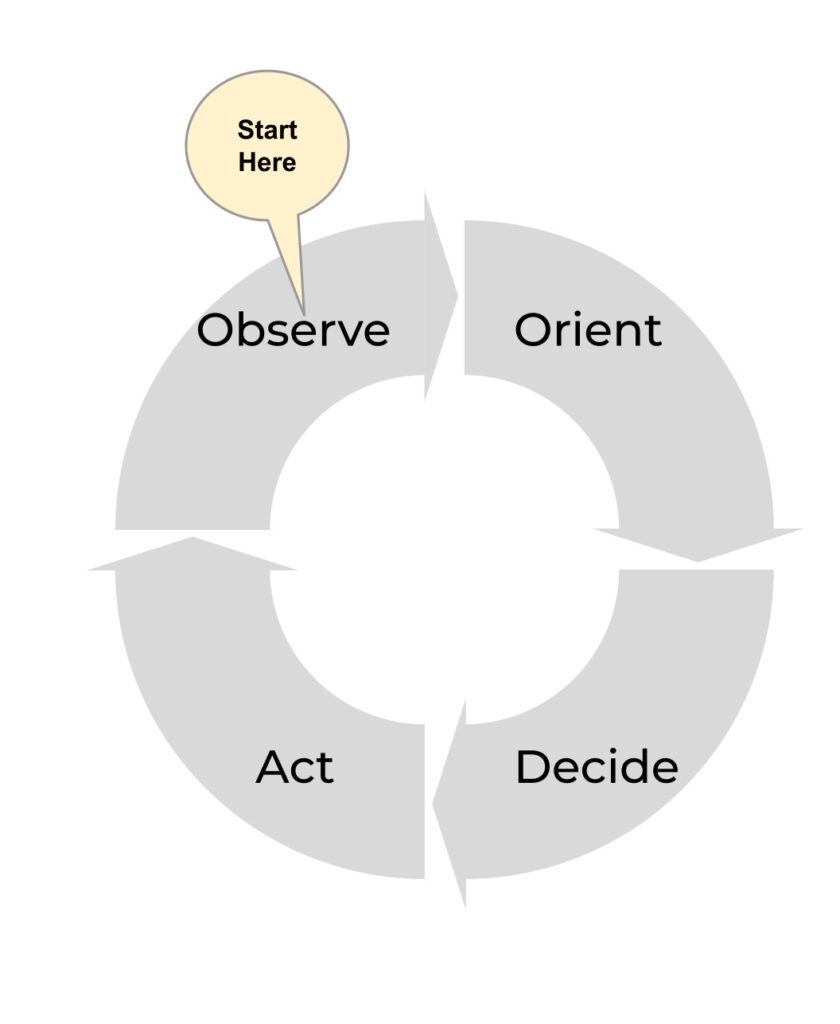Decision-making frameworks provide essential structure for navigating complex business challenges. The OODA Loop vs PDCA Cycle comparison highlights two powerful methodologies that guide teams through uncertainty, each with distinct approaches to problem-solving and process improvement.
But which one should you implement in your organization?
In this guide, we’ll break down the core components of each framework, reveal their ideal use cases, and provide practical implementation strategies to drive results in your specific business context.
Ready to transform your decision-making and gain a competitive edge?
Let’s dive in.
The Decision-Making Powerhouses: OODA Loop and PDCA Cycle
Decision-making frameworks provide structure when navigating complex business challenges. Both the OODA Loop and PDCA Cycle offer distinct approaches to problem-solving, each with unique strengths for different situations.
What Is the OODA Loop?

The OODA Loop originated from military strategy, developed by U.S. Air Force Colonel John Boyd during the Korean War. Boyd created this decision-making cycle to help fighter pilots make faster, better decisions than their opponents. The name comes from its four sequential steps: Observe, Orient, Decide, and Act.
This framework excels in high-pressure environments where speed matters. Organizations facing rapidly changing market conditions or competitive threats can gain significant advantages by implementing this approach. The OODA Loop prioritizes quick adaptation over perfect information.
At its core, the framework helps teams cycle through four essential elements:
- Observe: Gather raw data from multiple sources about your environment, competitors, and current situation.
- Orient: Process and analyze the observed information through your unique perspective and organizational context.
- Decide: Determine the most appropriate course of action based on your oriented understanding.
- Act: Implement your decision and return to observation as you monitor results.
We’ve created a comprehensive guide on the OODA Loop that dives deeper into each phase, providing detailed implementation strategies and practical examples.
What Is the PDCA Cycle?

The PDCA Cycle (Plan-Do-Check-Act), also known as the Deming Cycle, emerged from the quality management world, developed by management consultant W. Edwards Deming in the 1950s. Initially introduced as the Shewhart Cycle, Deming promoted this approach to help Japanese manufacturers improve product quality after World War II.
Unlike the OODA Loop’s focus on speed, the PDCA Cycle emphasizes methodical improvement and error reduction. Organizations seeking consistent quality improvements and process optimization typically embrace this framework.
This systematic approach works particularly well for established processes that need refinement.
The PDCA Cycle breaks down into four distinct phases:
The PDCA methodology guides teams through four sequential phases, each designed to ensure thorough process improvement:
- Plan: Define the problem, collect relevant data, and establish clear objectives for improvement.
- Do: Implement the planned solution, typically starting with a small-scale test or pilot program.
- Check: Measure and analyze results against expected outcomes and original objectives.
- Act: Standardize successful changes or begin the cycle again with new insights if results fall short.
For a deeper exploration of this quality-focused methodology, check out our in-depth PDCA Cycle resource.
PDCA vs. OODA: What’s the Difference?
These frameworks might seem similar at first glance, yet they serve distinct purposes and excel in different scenarios. Understanding these key differences helps you choose the right approach for your specific challenges.
Here’s a quick glance at their key differences:
| OODA Loop | PDCA |
| Fast-paced, thrives on rapid execution. Ideal for high-stakes, competitive situations. | Methodical, prioritizes thorough analysis. Best for quality control and process stability. |
| Focuses on agility and quick adaptation. Short decision cycles offer a competitive edge. | Emphasizes structured planning and long-term improvement. Sacrifices speed for precision. |
| Designed to outmaneuver competitors. Best for business strategy, military, and competitive environments. | Aims for continuous improvement and refinement. Common in manufacturing, healthcare, and service industries. |
| Works well with incomplete data. Encourages action based on best available insights. | Relies on comprehensive data collection. Decisions are based on detailed analysis. |
| Encourages flexibility, calculated risks, and quick adjustments. | Ensures stability, predictable outcomes, and systematic refinements. |
Speed and Response Time
The OODA Loop thrives on rapid execution and quick decision cycles. It’s designed for environments where being fast matters more than being perfect.
Teams using OODA can process information and make decisions in minutes or hours rather than days or weeks. This rapid cycling creates a competitive advantage, especially when facing similarly skilled opponents.
PDCA operates at a more measured pace, with each phase requiring thorough completion before advancing. This deliberate approach prioritizes accuracy and thoroughness over speed.
Organizations implementing PDCA accept longer timelines in exchange for higher confidence in outcomes. When quality control matters more than immediate response, this tradeoff makes strategic sense.
Methodical Approach
PDCA takes a deliberate approach, emphasizing thorough analysis over pure speed. The planning phase alone may take days or weeks to properly identify problems and develop solutions.
Organizations using PDCA create detailed implementation plans with clear metrics for success. This structured methodology builds consistency and reliability into improvement efforts.
The OODA Loop embraces a more flexible methodology that adapts to changing conditions. It prioritizes adaptability over rigid processes, allowing teams to adjust their approach as new information emerges.
Teams using OODA develop the ability to make rapid course corrections without excessive planning overhead. This adaptability proves particularly valuable in environments where conditions change faster than formal plans can account for.
Focus and Purpose
The OODA Loop primarily focuses on gaining competitive advantage through superior decision-making speed. It originated in combat situations where outmaneuvering opponents determined survival.
Teams implement OODA when they need to disrupt competitors’ decision-making processes. Creating confusion in your market while maintaining your own clarity creates significant advantages.
PDCA centers on excellence through systematic improvement rather than competitive positioning. Its focus lies in enhancing established processes through methodical cycles of planning, implementation, evaluation, and standardization.
Organizations adopt PDCA when seeking predictable quality improvements and operational excellence. This approach builds customer trust through consistent delivery rather than rapid market maneuvers.
Improvement Orientation
PDCA centers on continuous improvement and error reduction. Its primary goal involves refining existing processes rather than outpacing opponents.
Companies apply PDCA when seeking ongoing operational excellence. The framework creates a culture of constant refinement rather than dramatic competitive moves.
The OODA Loop approaches improvement through rapid learning cycles and adaptation. Rather than focusing on incremental enhancement, it emphasizes building organizational agility and responsiveness.
Teams using OODA improve by accelerating their learning rate about markets, customers, and competitors. This approach creates improvement through faster innovation and adaptation rather than process refinement.
Information Requirements
The OODA Loop functions effectively with incomplete information. It acknowledges that waiting for perfect data often means missing opportunities.
Teams using OODA develop comfort with uncertainty and ambiguity. They learn to trust their orientation phase, using experience and expertise to fill information gaps.
PDCA demands more comprehensive data collection and analysis. The planning and checking phases rely heavily on measuring specific variables and comparing results against established standards.
Organizations implementing PDCA establish clear metrics before beginning implementation. This commitment to measurement creates more predictable outcomes but requires greater upfront investment.
Data Dependency
PDCA relies heavily on measurement systems and quality controls. The planning and checking phases depend on comparing results against established standards.
Organizations implementing PDCA invest heavily in measurement systems and quality controls. They create robust data collection processes to support evidence-based decision-making.
The OODA Loop operates with greater data flexibility, emphasizing contextual understanding over comprehensive metrics. This approach encourages teams to blend quantitative data with qualitative insights from experience.
Teams using OODA learn to make reasonable judgments with whatever information is available. This capability proves invaluable during crises or rapidly evolving situations where complete data is unattainable.
When to Choose PDCA vs OODA
Selecting the right decision-making framework significantly impacts your organization’s ability to respond effectively to challenges. Understanding the ideal context for each approach helps teams implement the most suitable methodology for their specific situation.
Here’s a quick reference table comparing when to choose OODA vs PDCA:
| OODA Loop Best For | PDCA Cycle Best For |
|---|---|
| Fast-changing markets with frequent disruptions | Established processes requiring systematic improvement |
| Crisis management situations requiring immediate action | Quality improvement initiatives focused on consistency |
| Competitive landscapes with rapid shifts | Compliance-focused operations needing documentation |
| Emergency response operations with time pressure | Manufacturing processes requiring error reduction |
| Tactical business situations with narrow response windows | Systems with clearly measurable performance metrics |
| New product launches needing rapid market feedback | Complex problem solving requiring root cause analysis |
| Startup environments with unproven market fit | Long-term performance enhancement of mature operations |
| Experimental projects with evolving priorities | Incremental improvement goals in stable environments |
| First-mover advantage situations | Standardization of service delivery processes |
| Innovation-focused initiatives requiring adaptability | Multi-variable challenges with interconnected factors |
When to Choose OODA Loop
Fast-Changing Environments
The OODA Loop excels in environments characterized by rapid change and uncertainty where conditions evolve faster than traditional planning cycles can accommodate. Organizations should implement this framework when facing market disruptions that require immediate response.
Crisis management situations particularly benefit from OODA’s emphasis on quick observation and orientation. When teams must rapidly assess developing situations with incomplete information, the framework provides structure without imposing rigid processes that might slow response time.
Businesses operating in competitive landscapes with frequent shifts should favor OODA over PDCA. Industries with low barriers to entry, rapidly evolving customer preferences, or frequent technological disruption require the ability to detect and respond to changes before competitors.
The OODA Loop’s orientation phase helps teams quickly make sense of emerging patterns while enabling faster pivots than methodologies focused on perfecting plans before implementation. This emphasis on speed over perfection creates competitive advantage in highly dynamic business environments.
Time-Critical Decision Making
OODA Loop frameworks shine in scenarios where delayed decisions carry significant opportunity costs or risks. Emergency response operations require immediate action based on limited information, making OODA’s rapid cycling more valuable than comprehensive planning.
Tactical business situations like responding to competitor price changes or supply chain disruptions benefit from the framework’s emphasis on action. The loop’s structure encourages teams to make reasonable decisions quickly rather than optimal decisions too late.
Opportunities with narrow windows demand the accelerated decision cycles that OODA provides. When first-mover advantage determines success, the ability to compress observation-to-action time becomes more valuable than exhaustive analysis.
The framework’s built-in learning mechanism allows teams to refine their approach through successive iterations. This creates a virtuous cycle where each action generates new observations that improve future decisions.
Innovation-Focused Initiatives
New product launches benefit from OODA’s emphasis on market feedback and rapid adaptation. The framework enables teams to release minimum viable products quickly and refine based on actual user experience rather than theoretical planning.
Startup environments naturally align with OODA’s principles of speed and adaptation in uncertain conditions. When market fit remains unproven, the ability to pivot quickly based on customer feedback often determines survival.
Experimental projects require frameworks that accommodate unexpected discoveries and changing priorities. OODA’s lightweight structure supports innovative thinking by reducing planning overhead and emphasizing learning through action.
The framework’s orientation phase encourages teams to view situations through multiple perspectives. This cognitive flexibility proves particularly valuable when developing novel solutions or entering unexplored markets.
When to Choose PDCA Cycle
Quality Improvement Initiatives
PDCA excels in environments where consistency and error reduction directly impact business outcomes. Manufacturing processes with established parameters benefit from PDCA’s methodical approach to identifying and eliminating sources of variation.
Service delivery standardization requires the systematic approach that PDCA provides. The framework’s emphasis on measurement and verification ensures that improvements actually deliver the intended customer experience.
Compliance-focused operations depend on PDCA’s documentation and verification components. When regulatory requirements demand evidence of controlled processes, PDCA’s structured approach provides both improvement and documentation.
The cycle’s check phase ensures that changes actually produce the anticipated results before standardization. This validation step prevents organizations from institutionalizing changes that seem logical but fail to deliver real-world improvements.
Established Process Optimization
Mature business operations with defined workflows benefit from PDCA’s incremental improvement approach. The framework helps teams systematically identify bottlenecks and inefficiencies without disrupting core business functions.
Systems with measurable performance metrics provide the data foundation that PDCA requires. When baseline performance can be quantified, the cycle provides a structured path to meaningful improvements.
Incremental improvement goals align perfectly with PDCA’s methodical nature. Organizations seeking consistent, sustainable gains rather than dramatic transformation find PDCA’s measured approach reduces implementation risks.
The act phase ensures improvements become standardized rather than temporary fixes. This institutionalization of better practices creates a foundation for future improvement cycles.
Complex Problem Solving
Multi-variable challenges with interconnected factors benefit from PDCA’s comprehensive planning phase. The framework encourages thorough analysis before action, reducing unintended consequences when making changes to complex systems.
Issues requiring root cause analysis rather than symptom treatment align with PDCA’s analytical approach. The plan phase provides time and structure to identify underlying factors rather than implementing quick fixes that address only surface problems.
Long-term performance enhancement requires the sustained focus that PDCA provides. Organizations addressing systemic challenges benefit from the framework’s emphasis on thorough analysis and measured implementation.
The cycle’s iterative nature supports sequential improvements toward challenging goals. This allows teams to break down complex problems into manageable components that can be addressed systematically.
Hybrid Approaches
When to Combine Frameworks
Organizations facing both stability and disruption may benefit from applying different frameworks to different business functions. Established operations can follow PDCA for optimization while innovation initiatives implement OODA for agility.
Different business units often have varying operational tempos and risk profiles. Companies can train teams in both methodologies, applying each where contextually appropriate rather than forcing a one-size-fits-all approach.
Projects with evolving requirements may shift between frameworks as they mature. Early-stage initiatives might leverage OODA for rapid learning and pivoting before transitioning to PDCA as processes stabilize.
The frameworks share fundamental principles despite their different emphases. Both ultimately support informed decision-making through structured observation and learning, allowing organizations to blend elements based on specific needs.
Transition Strategies
Moving from crisis response to stabilization often requires shifting from OODA to PDCA as conditions permit. Initial OODA cycles help organizations respond to immediate challenges, while PDCA provides structure for sustainable solutions once the situation stabilizes.
Scaling from startup to established organization typically demands evolving decision frameworks. OODA supports the rapid iteration and market discovery of early-stage companies, while PDCA helps institutionalize successful approaches as operations grow.
Converting innovations into standard processes represents a natural transition point between frameworks. OODA supports the experimental phase of innovation, while PDCA helps operationalize proven concepts into reliable business processes.
Organizational maturity often dictates the appropriate balance between these methodologies. Leadership teams should recognize when shifting conditions require adjusting their decision-making approach rather than rigidly adhering to a single framework.
OODA Loop vs PDCA Cycle: Final Thoughts
The OODA Loop and PDCA Cycle offer powerful yet distinct approaches to decision-making and process improvement for today’s organizations. Your specific context, competitive landscape, time constraints, and organizational culture, should guide which framework you implement or how you might combine elements of both.
Mastering these methodologies gives your team valuable tools to navigate uncertainty, drive continuous improvement, and ultimately create significant competitive advantages in our increasingly complex business environment.
Frequently Asked Questions
Can I combine elements of both OODA and PDCA in my organization?
Absolutely! Many successful organizations create hybrid approaches that leverage OODA’s speed for market-facing decisions while using PDCA for internal processes and quality control. This balanced approach allows you to respond quickly to competitive threats while maintaining methodical improvement in operational areas.
How long does it typically take to implement these frameworks effectively?
Implementation timelines vary based on organization size and existing culture. Most teams report 3-6 months to see meaningful results with OODA, while PDCA typically requires 6-12 months to fully embed in operational processes. Start with small pilot projects before attempting organization-wide rollouts.
Do these frameworks work equally well in non-profit or government settings?
Both frameworks transfer effectively to non-profit and government environments despite their business and military origins. OODA proves valuable for disaster response and policy adaptation, while PDCA excels in program evaluation and service delivery improvement. The key is adapting the language to fit your organizational context.

We empower people to succeed through information and essential services. Do you need help with something? Contact Us.
Want a heads-up once a week whenever a new article drops?







